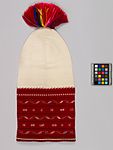Hat
About this object
History of use
The colour, extent of patterning, shape and the manner in which 'chullus' or caps are worn signifies differences in age, sex and status of wearer. Females wear chullus in early childhood, but only males wear them later in life. Knitting is done only by men and boys, traditionally for chullus, but more recently for vest fronts, coin purses, gloves, ties, vests and sweaters which are sold to tourists. This half patterned style is designated for unmarried men but is in fact worn by many married men, particularly for community work or other group activities. The pentay chullu, or totally patterned hat, is worn only by married men. A many coloured 'chullu' with earflaps is worn by the island authorities. Young children wear 'chullus' with brims and the sexes are differentiated by the brown or white crown.
Narrative
Made by a cousin of the seller, Gonzalo Yucra Huatta. Gonzalo bought it when his cousin needed money and then displayed it at a retail fair of Taquile handcrafts in Lima.
Iconographic meaning
The flower and stepped diagonal motif is called 'cinta lawar' in Quechua and 'camino y rosas' (road and flowers) in Spanish.
Specific techniques
Synthetic commercial yarns are z spun, plied 2-s. Cap is knitted in the round with 5 needles. Worked with the inside of the cap facing and worked with the purl stitch. Extra colours are added in local areas. Shaping is done on the needles. Tassel is sewn on.
Physical description
Conical shaped, red and white knitted stocking cap with a thick red tassel accented with brilliant colours. The lower half has a red background and is divided into six bands with small scale patterns. Three bands have an eight petal shape joined by stepped lines. Two bands have discrete geometric and figurative designs and the uppermost has an interlocking reverse curve. The upper section is white and tapers to a point. The yarn is very smooth and the stitches very fine. There is a break in the knitting at the lower edge and another small one in the centre of the red section. The patterns are orange, pink, blue, green, yellow, orange and navy.
Categories
Materials
